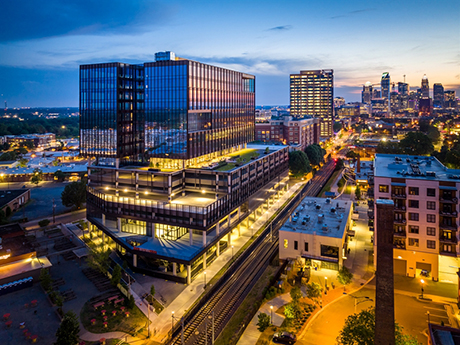By Chase Monroe, Carolinas Market Director and Charlotte Brokerage Lead, and Chris Schaaf, Executive Managing Director of Tenant Representation, JLL
Nearly two years after the onset of the pandemic, Charlotte’s office market is showing strong signs of recovery as economic momentum builds. Last year, the Queen City set the stage for growth with 4.9 million square feet of office space delivered from pre-pandemic projects, boasting over 1 million square feet more than any other metro for deliveries that occurred in 2021.
Market-wide preleasing also exceeded 60 percent and nearly 2.1 million square feet of office space was under construction. Entering 2022, the market continued to forge ahead as large occupiers started their return to the office, and leasing activity began to surge throughout the region. And long-anticipated projects, such as Legacy Union, 110 East and The Station broke ground.
According to Urban Land Institute’s 2021 annual report, Charlotte ranked No. 6 among the hottest real estate markets in the United States, with developers and investors betting big on Sun Belt cities. Deemed an 18-hour magnet city by the Emerging Trends in Real Estate survey, people and businesses alike are flocking to Charlotte, the so-called “migration destination.”
Thanks to strong economic fundamentals that include rising levels of population and job growth, nearly 4,700 net new jobs were added across the region during the first quarter alone, as well as nearly $2.2 billion in announced capital investment.
Charlotte’s South End district continues to dominate the market in terms of leasing and construction activity, most of which is driven by the delivery of new product. Noteworthy projects include Queensbridge Collective, a 41-story, 810,500-square-foot office building, and 110 East, a 360,000-square-foot office building expected to deliver in the fourth quarter of 2024.
So far in 2022, nearly 60 percent of the 4.1 million-plus square feet of office space under construction in Charlotte is in South End or Uptown. Of the buildings that delivered in the past two years, 79 percent of newly delivered space in Uptown and South End has been leased, and 68.3 percent of new space across all central business district submarkets has been leased.
Further examining the market, leasing activity nearly doubled in the first quarter compared to the fourth quarter of 2021 as new product started to control the market movement. Multiple large announcements contributed to this, but the primary source of leasing activity in the first quarter was Vantage South End. The 635,000-square-foot mixed-use development added five floors of leases totaling more than 130,000 square feet in the first quarter alone.
Flight to quality continues
As large occupiers return to the office after years of remote work, many are reevaluating their real estate needs and footprints. As a result, many top employers continue to seek high-quality, new-construction office buildings located in amenity-rich areas. The flight-to-quality trend will continue to amplify a widening gap between classes of office buildings.
JLL’s research shows that flight to quality is being driven by outsized leasing in new construction. In Charlotte’s CBD, completions in the past two years are nearly 70 percent leased as the flight to new, highly amenitized office remains unwavering.
One example is the 742,000-square-foot Ally Charlotte Center, which delivered last year and is fully occupied by Ally Financial’s team of 2,800 employees. The banker plans to add 1,000 jobs in the coming years. Well-located between the bustling Uptown and South End, Ally Charlotte Center has convenient access to the region’s most desirable dining, retail and entertainment options.
As new construction brings to market trophy and Class A products, there is a clear opportunity for older buildings to offer discounted rates and increase tenant diversity in the metro area. It’s also important to note that many existing office assets in Uptown underwent renovations over the last five years, further positioning the region for success compared to other metro submarkets.
Top tech town
A recent study by CompTIA found that Charlotte ranked as the No. 6 tech town in the country, with fintech continuing to drive market activity. Investment by fintech giants such as Credit Karma, USAA and Robinhood is spurring population growth and additional development in the region as investors are drawn to Charlotte’s strong fundamentals. According to JLL’s Discover Charlotte report, there was a 31.1 percent increase in the tech talent labor from 2016 to 2020, and 120 percent growth in tech companies in Charlotte from 2010 to 2020.
Last year, the JLL team represented USAA in its lease of six floors, or about 93,000 square feet, at The Square at South End — an investment that created nearly 750 new jobs. Similarly, Credit Karma unveiled its new East Coast headquarters in Ballantyne last month, adding 600 jobs and investing $13 million in the renovation. This included adding roughly 100,000 square feet to its Ballantyne-area office.
These leaders in the market will continue to entice out-of-state firms looking to expand to cities with a concentration of tech talent, low cost of living and business-friendly tax climate. In fact, Charlotte is home to over 60 fintech companies, positioning the city as an influential and leading force in the industry.
Poised for growth
Already landing as the 15th largest city in the nation with a current population of 3.1 million people, the ever-growing Queen City expects to see its population grow by 50 percent by 2050. Despite lingering effects of the pandemic, innovative and talent-rich cities like Charlotte continue to thrive.
The market’s highly educated talent pool, desirable climate, affordability and concentration of top employers will continue to make it a great place to live and work for generations to come.
This article was originally published in the June 2022 issue of Southeast Real Estate Business.




